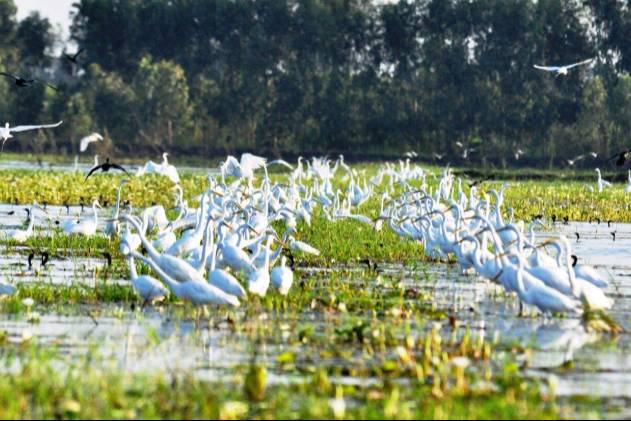In response to World Wetlands Day (February 2) in 2025, Viet Nam is organizing various activities under the theme: "Protect Wetlands for Our Future." These activities aim to highlight the collective efforts of communities in safeguarding wetland ecosystems, ensuring that everyone continues to benefit from the essential services they provide.
According to the Department of Nature Conservation and Biodiversity (Ministry of Natural Resources and Environment), Viet Nam currently has approximately 11.85 million hectares of wetlands, accounting for 37% of the country's total natural land area. The Mekong Delta has the largest wetland area, covering nearly 49%, while the Central Highlands has the smallest, at just 3%.
Viet Nam 's wetlands are classified into two main groups with 26 types: artificial and natural (inland and coastal). Artificial wetlands constitute the largest share, 72% of the total wetland area. Of this, rice fields alone account for 67%, coastal wetlands for 18%, and inland wetlands for 10%.
Rivers have shaped vast and fertile delta regions, such as the Red River Delta and the Mekong Delta, which are crucial for agricultural production. Meanwhile, coastal wetlands have long provided fishery resources for many local communities.
Beyond their significant economic value, wetland ecosystems are crucial in environmental regulation, disaster risk reduction, and climate change adaptation. They also serve as the foundation for many historical and cultural values within local communities.

Since joining the Convention on Wetlands (Ramsar Convention) 36 years ago, Viet Nam has had nine protected areas recognized as internationally important wetlands (Ramsar sites), covering over 120,000 hectares. These include 7 national parks: Xuan Thuy (Nam Dinh), Ba Be (Bac Kan), Bau Sau - Cat Tien (Dong Nai), Tram Chim (Dong Thap), Mui Ca Mau (Ca Mau), Con Dao (Ba Ria Vung Tau), and U Minh Thuong (Kien Giang) and 2 nature reserves Lang Sen (Long An) and Van Long (Ninh Binh).
Currently, 23 provinces and cities in Viet Nam have developed biodiversity conservation plans, identifying key wetland areas that require protection and management as nature reserves. In total, 47 significant wetland sites have been included in the National Biodiversity Conservation Master Plan until 2020, with an orientation toward 2030, as outlined in Decision No. 45/QĐ-TTg issued by the Prime Minister on January 8, 2014.